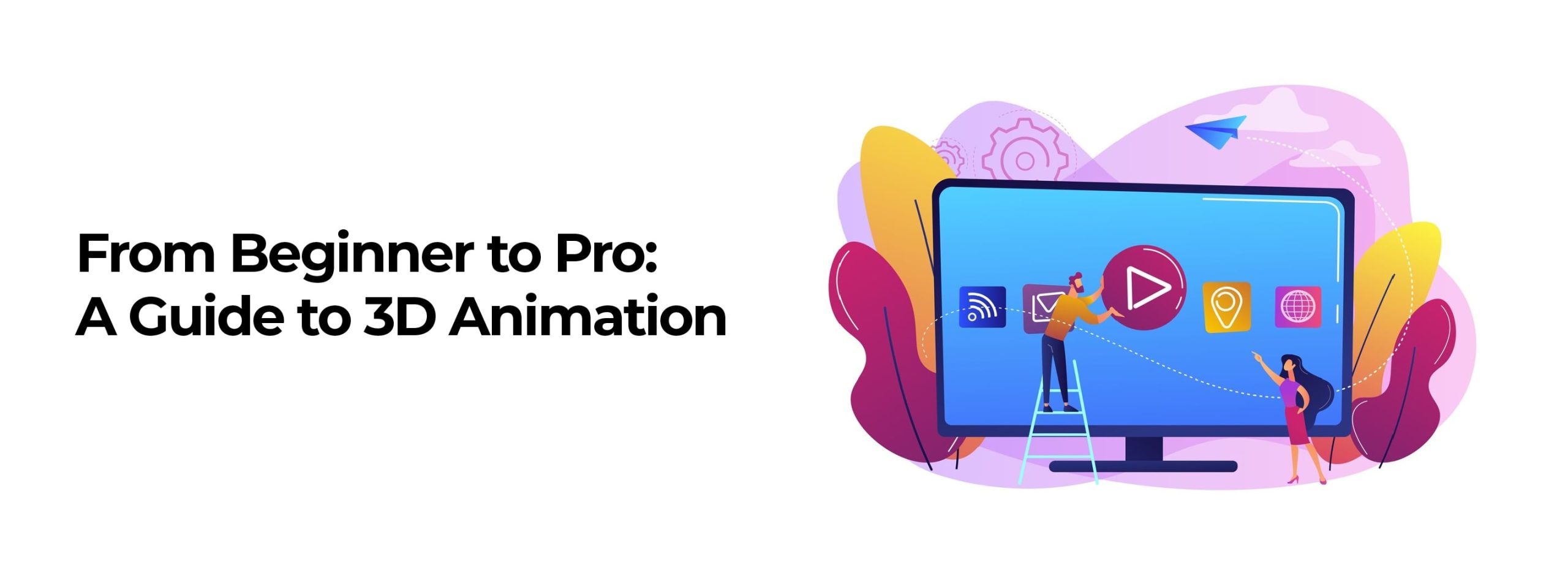How to Make A 3D Animation? Five Simple Steps to Follow
3D animation, also called 3D digital animation, has revolutionized how we perceive visual storytelling and communication. Over the years, the world of 3D animations has undergone remarkable transformations, showcasing unprecedented advancements in technology and creativity. From its inception, where basic shapes were painstakingly sculpted into primitive animations, to the present day, where intricate worlds and characters come to life with lifelike realism, the evolution of 3D animations is awe-inspiring.
But have you ever wondered how these stunning animations are created? If you’re a creative individual eager to dive into the world of 3D animation, look no further. In this Blog, we will guide you on how to make a 3d animation through the step-by-step process of making your own 3D animation, from conceptualization to final rendering; we got it all covered; get ready to discover the animator inside you and explore the process of 3D animation with us.

How to Make A 3d Animation
In the modern era of technology, 3D animation has gained immense popularity and has become a highly engaging method to capture the audience’s attention. From blockbuster films to video games, this technology has engaged audiences for numerous years, providing continuous entertainment,
An excellent contemporary example of a 3D animated film that has captivated viewers with its vibrant characters and breathtaking scenes is “Coco.” In “Coco,” Miguel’s vibrant character starts on a magical adventure to the Land of the Dead, where he uncovers family secrets and discovers the importuance of heritage. The film’s 3D animation brings to life the dazzling Land of the Dead, with its intricate and colorful architecture, bustling streets, and lively characters from both the world of the living and the deceased.
Animation breathes life into characters, and 3D animation involves a meticulous process combining artistic skills with cutting-edge technology. Follow these steps to create 3D animations:

Choosing the Right Software and Tools
Selecting the appropriate software and tools is paramount in 3D animation. Autodesk Maya, Blender, or Cinema 4D software offers powerful modeling, rigging, animating, and rendering features. Depending on your project’s complexity and familiarity with the software, choose one that aligns with your creative needs and goals.
Autodesk Maya: Renowned for its comprehensive toolset, Autodesk Maya stands as a staple in professional 3D animation. With a rich history in the industry, Maya offers advanced features for character rigging, intricate animation, and realistic rendering. Its versatility extends to various industries, from film and gaming to architecture and visual effects.
Blender: A notable open-source alternative, Blender has emerged as a potent force in the world of 3D animation. Boasting a robust suite of tools, Blender provides modeling, sculpting, and animation capabilities and a passionate community of users. Its accessibility and no-cost entry make it a favored choice for novices and seasoned artists.
Cinema 4D: Renowned for its user-friendly interface and efficiency, Cinema 4D is revered in industries that demand quick-turnaround animation. This software excels in motion graphics and visual effects, seamlessly integrating with other suites. Its intuitive approach appeals to designers seeking powerful results without steep learning curves.
Ultimately, the right software elevates your creative process, allowing you to breathe life into your 3D animations with precision and finesse.
Get your Free 30 Minute strategy session with an experienced digital animators

Creating a Storyboard and Planning the Animation
Storyboarding is not just about sketching your ideas; it is a crucial step in the 3D animation process that helps bring your story to life. It allows you to visualize and plan the flow of your animation, ensuring that every shot and scene aligns with your intended narrative. Each frame in a storyboard represents a specific moment, giving you an apparent visual reference of how everything will unfold.
When creating a storyboard, it’s essential to focus on capturing the key moments and emotions that drive your narrative forward. Think about how each scene will contribute to the overall story arc, and consider the pacing and rhythm of your 3D animation. By carefully planning each shot and transition, you can ensure that your animation engages viewers from start to finish.
Overall, investing time into creating a detailed storyboard doesn’t just save production time; it enhances creativity by visualizing ideas before they become tangible animations. The more effort put into this early planning phase, the smoother the subsequent stages of production will be. So whether you are working on a short film or an advertising campaign, consider the power of storyboarding as an essential tool for success in animated storytelling.
Building and Rigging 3D Models
Building and rigging 3D models in 3D animation is an intricate process that requires both technical skills and artistic creativity. The first step in creating a 3D model is building the basic structure using polygons or NURBS surfaces. This involves shaping the model by manipulating vertices, edges and faces to create the desired form. Attention to detail is crucial at this stage, as even minor errors can affect the final result.
Once the model is built, it’s time to rig it for 3D animation Rigging involves adding a virtual skeleton to the model, enabling animators to realistically control their movements. This process includes setting up joints and IK (inverse kinematics) handles that determine how different body parts move relative to each other. It also involves assigning weight values to different parts of the mesh so they deform naturally during movement.
Successful building and rigging of 3D models require a combination of technical knowledge and artistic intuition. While technical expertise ensures accurate modeling and efficient rigging, artistic creativity brings life and personality into these virtual characters. By striking a balance between attention-to-detail and imaginative thinking, animators can create stunning 3D models that captivate viewers’ emotions and tell compelling stories through movement alone.
Animating Your Models in 3D Space
This step is where the magic happens. Animating your models in 3D space is the heart and soul of giving life to your creations. By applying the principles of 3D animation, you can add movement, personality, and emotion to your models. At this stage, you have the power to make them walk, fly, or dance.
Timing and spacing is a key principle to remember when animating in 3D space. This involves understanding how fast or slow an object moves from one point to another and the distances between each position. A quick movement may convey excitement or urgency, while a slow and deliberate motion can evoke a sense of tranquility or suspense.
Another important principle is anticipation. Creating an anticipation pose that foreshadows the movement is crucial before a major action occurs, such as a jump or punch. This builds tension and makes the resulting action more impactful for the viewer.
Lastly, remember to add secondary motion. While animating your main character or object may be your primary focus, incorporating secondary motions like hair swaying in the wind or clothes rippling adds an extra layer of realism and detail that breathes life into your scene.
Remember that 3D animation allows you to tell stories through movement. Experiment with different techniques and styles until you find what works best for your models’ personalities and narratives. Let your creativity shine as you bring your 3D models into motion.
Adding Textures, Lighting, and Special Effects
When it comes to creating realistic 3D animation, adding textures is a game-changer. By mapping textures onto the surfaces of your models, you can give them the appearance of real-world materials, such as wood, metal, or fabric. This enhances their visual appeal and adds a level of depth and realism that would otherwise be lacking.
In addition to textures, lighting is crucial in bringing your 3D animation to life. Properly placed lights can create different moods and atmospheres within your scene. Whether you want to simulate natural daylight streaming through a window or create a dramatic effect with bold shadows, careful attention to lighting can elevate your work from ordinary to extraordinary.
To take your 3D animation further, consider adding special effects. Special effects can add excitement and energy to your scenes, from particles and explosions to smoke and fire. They allow you to simulate real-world phenomena that are difficult or impossible to capture with traditional techniques alone.
By combining texture mapping with skilful lighting techniques and strategic use of special effects, you have the power to transform simple 3D models into immersive works of art that captivate your audience’s imagination. So don’t just settle for basic shapes; unleash the full potential of your creativity by exploring the endless possibilities offered by these powerful tools in the world of 3D modeling.
Wrapping up
In conclusion, creating a 3D animation can be an exciting and rewarding process that requires careful planning, attention to detail, and the right tools. By following the steps outlined in this blog, aspiring animators can confidently embark on their journey and achieve impressive results. From conceptualizing ideas to storyboarding, modeling, texturing, animating, and rendering, each step is crucial for bringing characters and objects to life. Investing time in research and practice is essential to develop skills and stay updated with the latest technology advancements.
For an even better 3D animation experience, consider contacting experts like Cloud Animations, we know to make your project shine.





